By Christopher R. Bartocci
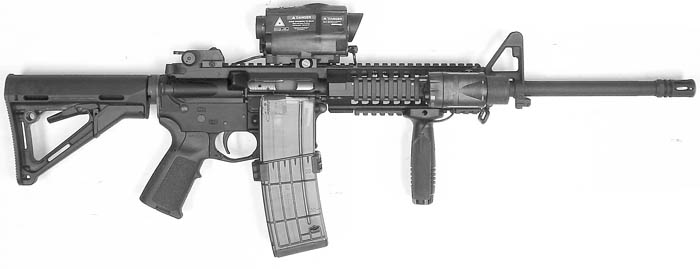
Throughout the years, flashlights were considered a separate entity from firearms – something to be held in the other hand. Around the time U.S. military personnel entered combat operations in Somalia, troops began to realize it would be advantageous to have the flashlights mounted to the rifle to keep the other hand free to reload the weapon, clear malfunctions or whatever else might need be done. So, troops began to tape small flashlights to the handguards of their weapons. Two specific needs were shown at this point. One was a method to mount accessories to the rifle with some type of rail system. The other was a secure way to mount a flashlight amongst other accessories to the rifle. The first inspired A.R.M.S., Inc. to develop their Rigid Frame System (later evolved into the SIR) and C. Reed Knight, Jr. to introduce his first RIS (Rail Interface System) and later RAS (Rail Adapter System). With the final standardization of the Swan/Mil-Std-1913 rail and the then RIS system, now flashlights could be easily mounted to the handguards of the M16/M4 series of weapons.
In 1988, Insight was founded in a basement workshop. Early products were rail mounted lasers and illuminators. One of the first prestigious contracts for Insight Tech-Gear would come from a revolutionary program of the newly developed United States Special Operations Command.
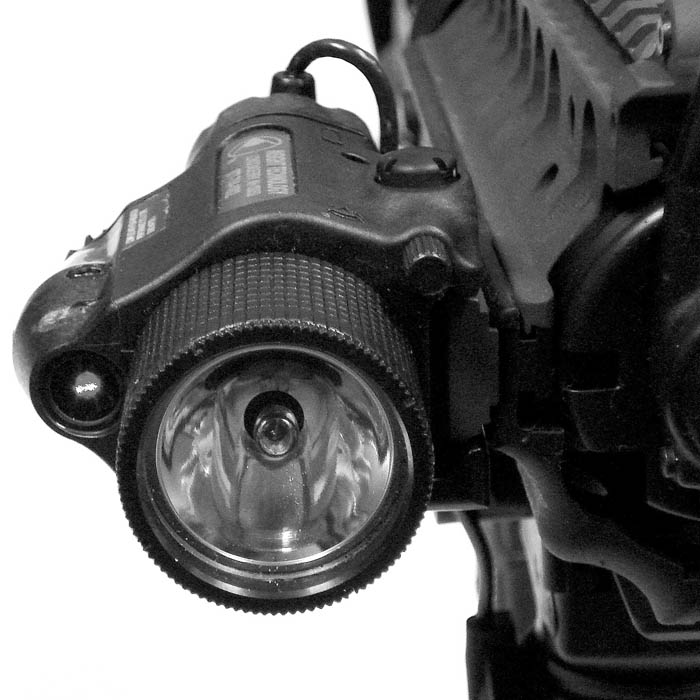
Illumination 101
There are many applications for illumination in a tactical situation. It may be for illuminating an entire room, outdoor use where higher brightness is needed, or perhaps infrared for covert use. The most common form of light is incandescent. This consists of a bulb utilizing a filament. There are several variations of this type of bulb that make it brighter and have more life. Filament is fairly cheap making it easy to maintain. The filaments used with Xenon gas is somewhat less expensive than the LED (to be discussed later). The tint offered off of a filament bulb has a yellow-orangeish color to it making it a little friendlier for identifying features of a person at a quick glance. Probably the most serious downfall to the bulb is that when this type of power is utilized (70+ Lumens), the bulbs burn pretty hot – enough that if accidentally left on in a nylon bag, it could melt the nylon.
The other and growing popular illumination option is called LED or Light Emitting Diode. This technology became widely available in the late 1990s. This technology, although slightly more expensive, offers major benefits. The diode is much more durable with a life of 50 to 100,000 hours and the LED components are difficult to damage with external shock. LED has overtaken the efficiency standard of incandescent lighting systems. LEDs produce more light per watt than incandescent bulbs. The battery life is slightly better than the incandescent bulb and does not get anywhere near as hot. Due to these factors, it is not necessary to have back-up bulbs on hand. The LED has one minor trade off. They are more sensitive to malfunction under extreme ambient temperatures. There must be a proper heat-sink to maintain operating temperatures. The light from the LED is a bluish color. The bluish color can hide features of a person’s face as well as color of skin identification at a quick glance. Colors in general may be perceived differently with LED illumination that would not be altered with sunlight or incandescent illumination. However another incredibly useful use for the LED is target disorientation. When configured to do so, the LED can function in a strobing manner which when aimed at a target will disorient them and often will give just enough time to subdue the target before they can get their eyes refocused to do harm.
Insight Tech Gear Flashlights and Tactical Lights
Insight Tech Gear offers both incandescent as well as LED flashlights and tactical lights. Many models are manufactured of aluminum and are hard coat anodized for tough handling in all sorts of weather. Insight offers some different hand held LED flashlights. The H1X Proxima uses one Duracell Ultra (123) lithium battery with an LED output of 80 Lumens. This light is compact and could easily fit on one’s pocket or on a utility belt. The sample light put out an incredible amount of light for such a small package. The Proxima has settings for constant light, momentary as well as strobe capabilities. The H2X Arcturus is a rechargeable LED light. The H2X has an LED output of 120+ Lumens and the H3X Regulus has an astonishing 160+ Lumens of output. This model utilizes three Duracell Ultra (123) lithium batteries. All models have an activation button in the rear that activates and selects momentary, constant, strobe and dim settings. The LED flashlight provided for test and evaluation was the H3X Regulus. This LED flashlight can be held as a flashlight or placed on a mount and mounted to a rifle or any other type of long arm. There is a pressure activated button on the rear for moment or continuous illumination. The Regulus has settings for strobe, momentary, lock-out and continuous use of illumination. The LED output is 200+ Lumens of light and is powered by two 123 6volt batteries. The run time for the batteries is approximately 90 minutes on high power versus 400 hours on low power. The case of the light is made from aluminum alloy and is hard coat anodized to a black, tan or olive drab finish.
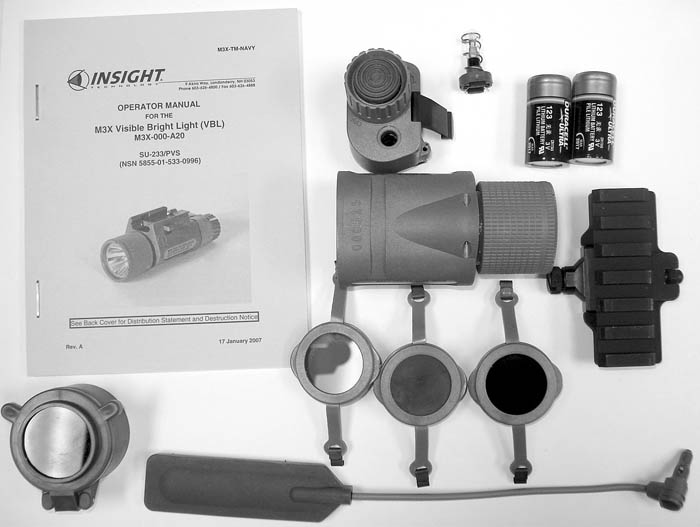
Additionally, the XTI Procyon is a module which will attach to the rail of a pistol or long arm which puts the LED into a tactical light. This gives a minimum LED output of 125 Lumens. A toggle switch on the rear allows the LED to perform in constant, momentary and strobe modes. There is a significant tactical application to the strobing features whether it be a LED in a flashlight configuration or weapons mounted. The strobing LED light will disorient a suspect for up to 2 seconds. This could take the place of a flashbang grenade (which serves the same purpose but on a much larger scale) under many entry circumstances. When taking a hostile suspect into custody, the strobing light could disorient them long enough to get them in cuffs and stop them from being a threat without the use of pepper spray or deadly physical force. The body is hard coat anodized aluminum for added strength. The rail interface is adjustable to fit any of the currently produced Mil-Std 1913 rails. The sample light was placed on a .45 Auto caliber Beretta Px4 pistol.
Insight has a host of various incandescent illumination lights. The M3 and M3X have a peak output of 90 and 125 Lumens respectively and can be attached to either a handgun or a long arm. This is as simple as switching the back plate. Pistol will utilize toggle steady-on or a contoured pistol remote back plate. For use with a long arm, a long gun back plate is used which has mode switch with three positions (off, mom and on). A pressure pad is plugged into the rear of the back plate.
The X2/X2L Series Xenon tactical light is designed to be installed on rails of sub compact pistols. The activation switch is a toggle style and is powered by a single CR2 3 volt battery. The peak output is 40+ Lumens.
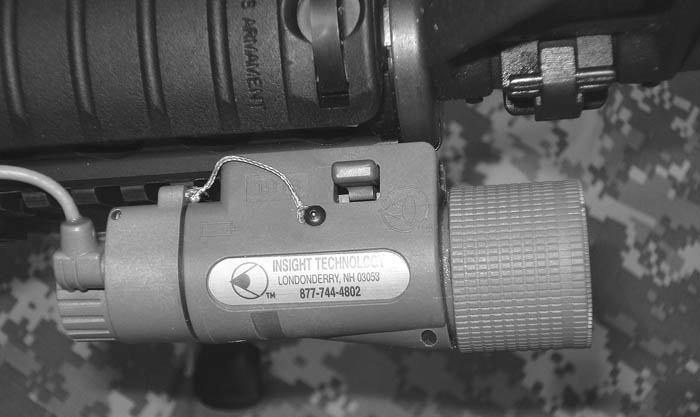
The M2 UTL (Universal Tactical Light) was designed for H&K for use with their USP pistol. This mount is designed specifically for the USP pistol and utilizes two 123 6-volt batteries for a peak output of 90+ Lumens. This was the first rail-mounted tactical light in the industry that offered blinding illumination which was actuated by a single finger and was rail mounted and installed without tools.
The vast majority of the Insight Tech-Gear’s LE/military lines of lights are tactical lights. This means the lights are designed to be mounted on the firearm. There are models specifically for mounting the lights on handguns as well as ones which will mount on any Mil-Std 1913 rail.
The Laser Aiming Module (LAM)
After all U.S. special operations units were brought under one umbrella, one of their first programs in August of 1991 was the OHWS (Offensive Handgun Weapon System). Due to the numerous sidearms utilized by the operators, it was conceived as an offensive weapon system including a pistol, laser aiming module and a suppressor. The pistol part of the competition would come down to Colt and Heckler & Koch with H&K being the winner. The new pistol was designated the MK23 Mod 0.
Insight would be selected as the winner for the LAM (Laser Aiming Module). The LAM would have a focusable visible illuminator, an infrared aiming laser, visible aiming laser, infrared laser illuminator and would be powered by two 123 6-volt batteries. The visible laser is a <5 mW power with a wavelength of 640±40nm and the infrared laser is .05-.10 mW power and has a wavelength of 830±50nm. The Infrared Illuminating Laser has a .15 – .65 mW power and has a wavelength of 830±50nm. Infrared lasers and illumination lasers are used in conjunction with night vision devices. The benefit of this is that nobody other than those wearing the night vision devices will be able to see the laser pointer or the illumination. This is useful for a commander to point out a target to his team or to take out targets quickly and accurately in low level to complete darkness. The visible white light illuminator has a brightness of >60 Lumens.
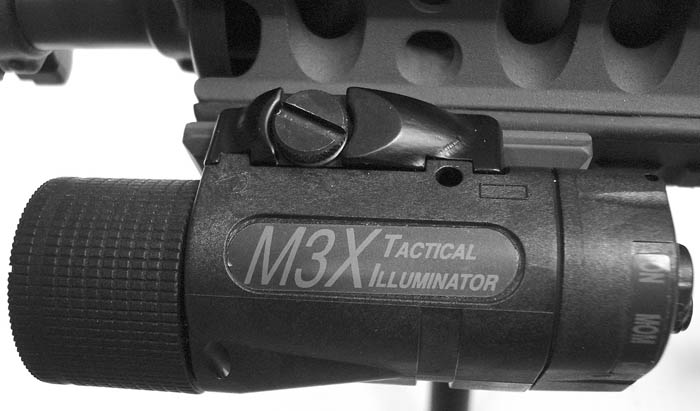
The LAM weighs 5.0 ounces and has a dial on the left side of the unit to permit the user to select the mode that he wants to use. These modes are IR with IR Illuminator, IR laser pointer only, OFF, VIS laser and VIS laser with Illuminator. There is a toggle switch beneath the unit that with a slight push to the side will get momentary on and all the way to either side will get continuous on. The lasers are adjusted individually by an Allen head wrench. However, the unit comes with an integral adjuster tool which is stowed in the face of the unit above the white light source. At the time of the introduction of the Mk23 Mod 0, there was no standardized rail. H&K developed their own rail and the LAM would mount to the rail and held in place by a thumb screw.
Insight Tactical Laser Aimers/Pointers
Although first applied to handguns, these universal units were fitted to long arms as well. Lasers have proven themselves in both the law enforcement as well as military area of operations. Lasers have many applications. As an aiming device, it enables the user to hit targets from any position without having to use the sights. If a SWAT officer is standing behind a shield, he will be able to reach his firearm around the side of the shield and use the laser to aim. For target identification, commanders are able to mark targets for the team so everyone is after the same guy. Lasers can also be used as intimidation in order to diffuse a situation before deadly force is deployed. Sometimes just the appearance of that dot on the target will be enough for the target to surrender. Another important, but often overlooked application to lasers, is in training. The laser can help a firearms instructor to see what problems the student is having. The laser will not be zeroed to point of aim. The magazine will have dummy rounds randomly placed unknown to the shooter. When the dummy is attempted to fire, the laser will show the instructor if the student is jerking or pulling and to what side. This will assist in corrective action. Many modules combine the laser pointer with the white light source.
Insight initially designed the LAM that grew into several generations of laser and illuminators. The M6 and M6X laser illuminators consist of both a laser and a white light. The white light is a 90+ and 125+ Lumen output light respectively with a 640±40nm laser pointer. They can be used simultaneously or separately. The visible illumination can be focused by rotating the bezel and the laser is adjusted by an Allen key. The back plate is determined by whether the unit will be mounted on a pistol or a long arm. If the unit is to be mounted on a pistol, a back plate with a toggle will be used. Lightly pressing activates the momentary power and all the way continuous is activated. To mount on a long arm, the long arm back plate is utilized. This contains a switch with three positions (off, mom and on). The laser has another switch behind it with settings for off, visible laser, illumination only and visible laser and illumination simultaneously. A pressure pad is plugged into the rear of the back plate. The pressure pad is the attached to the vertical pistol grip of handguard. The sights can be attached either by a Mil-Std 1913 mount, a universal mount or a Rail-Grabber. Options also include Bikini filters in IR, red and opaque.
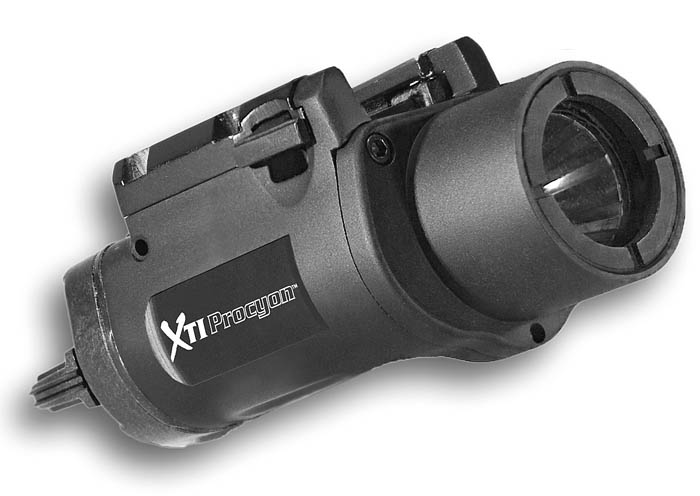
The X2 Laser tactical light and laser combination is designed to be installed on rails of sub compact pistols. The activation switch is a toggle style and is powered by a single CR2 3-volt battery. The peak output is 40+ Lumens. The laser is again activated with a toggle switch. The visible laser is a <5 mW power with a wavelength of 640±40nm. The laser point of impact is adjusted with an Allen key.
The LBS (Laser Borelight System)
This is one of those products that should be in any armory whether it is LE, military or gun shop. The sample provided for this article was put to use immediately and saves many rounds and a lot of time (especially on a freezing New York February day).
The LBS is a laser boresighting system that is used to boresight optics, lasers, as well as iron sights for 5.56mm, 7.62mm and .50 caliber firearms. This 4.5 ounce device is attached to a mandrel of the appropriate caliber bore and placed in the muzzle of the firearm. The activation dial has four settings (off, goggle, low and pulse). The goggle setting has the Borelight beam operate in a low power mode that is useful with night vision devices for night time zeroing. The low mode has the Borelight operate in a low power mode that is useful in low light conditions. The pulse setting allows the Borelight beam to turn on momentarily when the weapon is dry fired. The laser has a wavelength of 650±30 nm with a peak power of 0.9mW.
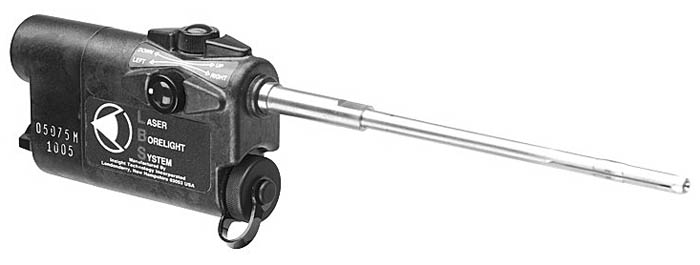
The provided test and evaluation M6X was boresighted with the LBS. The sight was placed on a SIR rail system on a Colt M4 carbine. The LBS was placed in the muzzle and the laser sight was adjusted to the boresight. At the range at 25 meters, the projectiles landed less than 1 inch to the left of the point of aim A couple of corrective clicks and done. The provided test and evaluation ISM-V (Integrated Sighting Module-Visible) was mounted on a LWRC M6A1 rifle and the LBS was used to boresight that unit as well. Both the laser and red dot on the ISM-V impacted a little more than an inch to the left at 25 meters. Another quick adjustment and done.
The Integrated Sighting Module
Red dot-type reflex sights have gained overwhelming popularity with military and law enforcement users. Currently, the most popular reflex sights are the AimPoint Comp2 and the new Comp 4 and the Trijicon ACOG reflex sight. The first uses batteries and the other is powered by a tritium lamp. Insight took an approach that uses both an optical reflex sight as well as a laser. Why not put both in one?
The ISM (Integrated Sighting Module) is just that, a combination of both a red dot (<2 MOA) reflex sight as well as a laser. The module fits onto any Mil-Std 1913 rail. Powered by a DL123 battery, the reflex sight features a red dot similar to that of the AimPoint Comp-series military reflex sights. The red dot can be made brighter or dimmer by adjusting the + and – buttons on top of the sight. There are a total of 18 brightness settings. The red dot is adjusted by elevation and windage adjustment screws. The battery life is approximately 1,500 hours for the red dot sight.
Also integrated into the unit is a laser sight. This red laser sight is simultaneously zeroed in when the red dot sight is so there is no need to zero them both. The laser can be activated with a button on the left side of the module or a remote switch can be plugged into the face of the unit. There are two models and the laser is the factor that differentiates between the two. The model provided for test and evaluation was the ISM-V, which the V stands for visible laser. The other model is the ISM-IR, which the IR stands for InfraRed. This model has both visible and IR lasers that are activated in the same manner. The ISM-IR has a switch on the rear of the unit that enables you to select either visible or IR mode. On the standard V model the selector has four settings (off, program, red dot and visible aim). The red dot is activated by pressing and releasing both the + and – buttons. To deactivate unit, press both buttons again. Your last brightness setting will be saved.
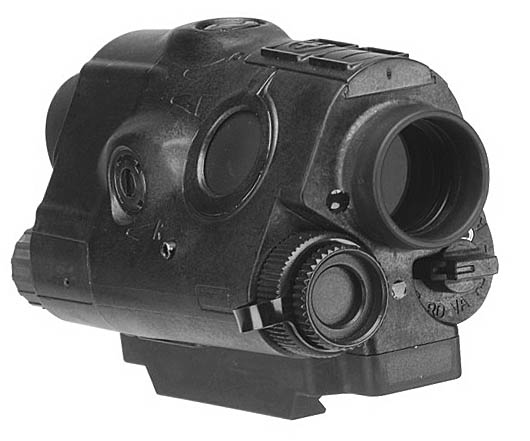
The test and evaluation unit was placed on a LWRC M6A1 5.56mm rifle: a piston operated variation of the M4 carbine. The unit was boresighted in at 25 yards with the LBS. When taken out for live fire at 25 yards the point of aim was 1 inch to the left. With a quick rotate of the windage, the weapon was zeroed in perfectly. After the red dot reflex sight was tested, the laser was then tested. As advertised, the laser was shooting to the exact point of aim as the redo dot. More than 500 rounds were fired in testing from several different positions in both semi and fully automatic fire. The sight remained point of aim throughout the shooting session. Off of a bench at 100 yards using Black Hills Mk262 Mod 1 ammunition, the rifle performed consistent 1-3/4 inch groups. The intensity of the red dot was decreased significantly to get a good aim point for accurate firing.
Tactical light, lasers as well as reflex sights have found their way into law enforcement, military as well as commercial weapons. Many companies are branching out to get into the market. Insight Technology has offered competitively priced top of the line products to serve all venues. They have several U.S. military contracts and their equipment is commonly used in the Global War on Terrorism. That is a tribute to the quality and confidence the end users have in their equipment.
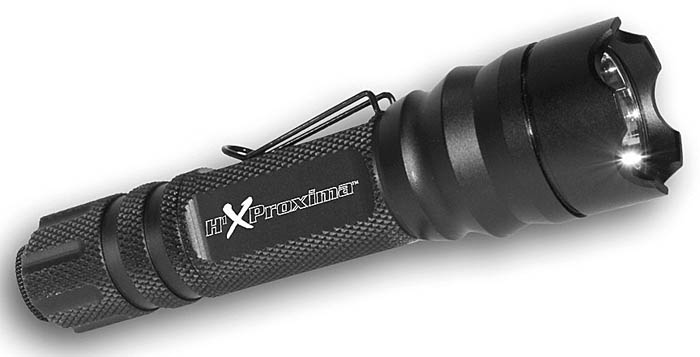
Insight Tech Gear
23 Industrial Drive
Londonderry, NH 03053
Phone: (877) 744-4802
Fax: (603) 668-1084
Web: www.insightlights.com
| This article first appeared in Small Arms Review V12N6 (March 2009) |











